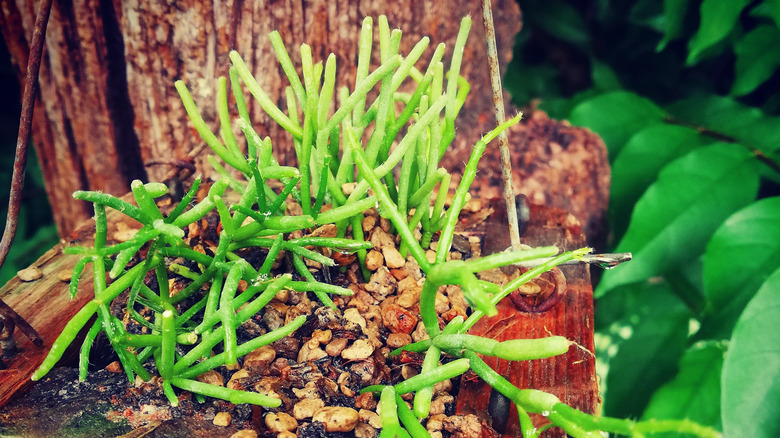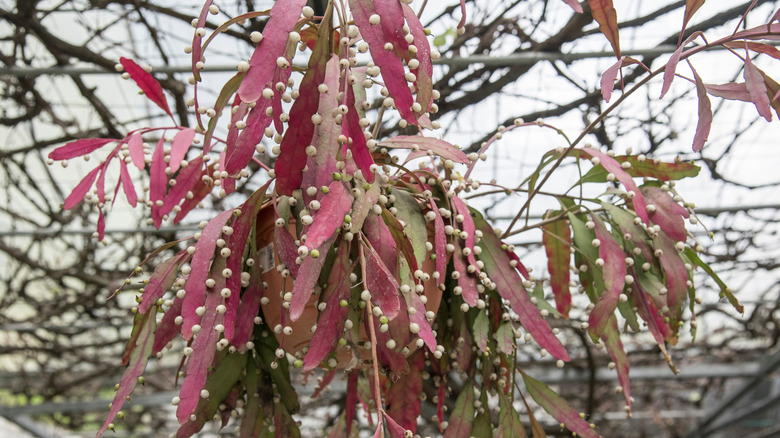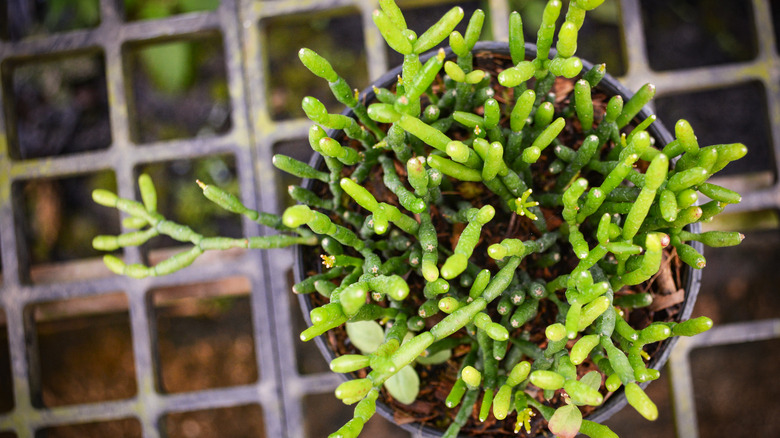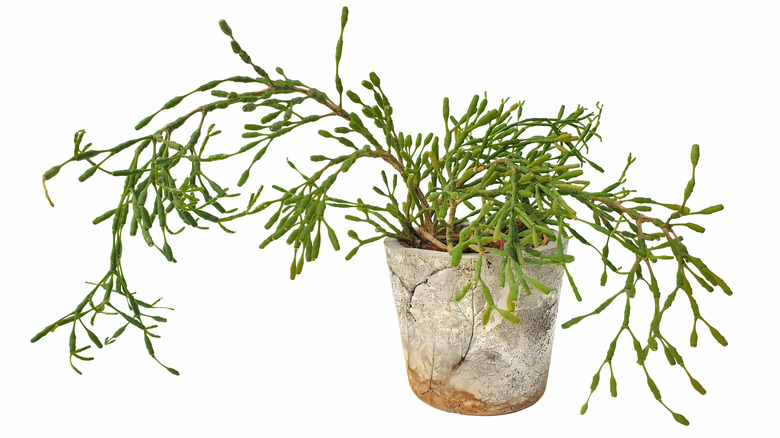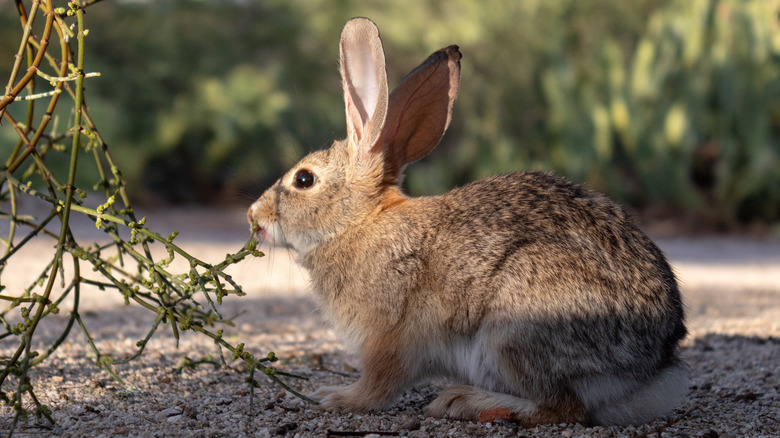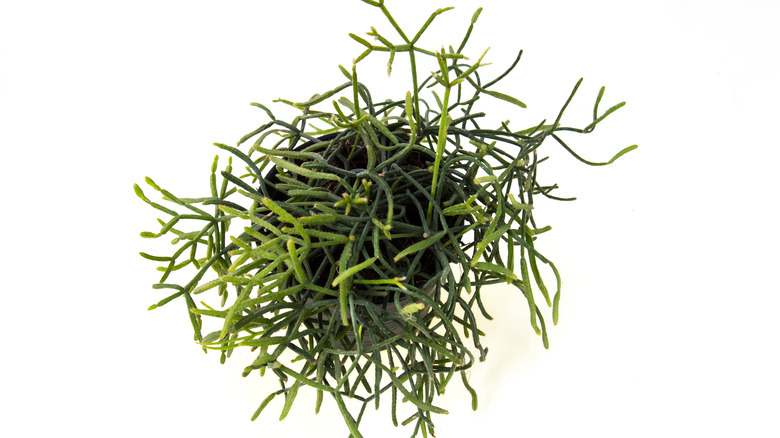How To Care For A Mistletoe Cactus
Mistletoe cactus (Rhipsalis baccifera), sometimes called chain cactus, is found in the southern U.S. throughout Mexico and into South America as well as Africa. It is a tropical native, and unlike many other plants called cacti, this succulent requires both moisture and shade. Mistletoe cactus is also epiphytic, meaning it grows hanging from rocks and tree branches. And while mistletoe cactus does not produce sharp and painful thorns like its relatives, its segmented stem surface do display small bumps instead. These pencil-width stems can reach as much as 30 feet long in nature, although a quarter of that is more common when grown at home.
They're equally popular indoors and outdoors because they're relatively easy to grow and maintain, and they bloom and produce edible fruit year-round. They prefer temperatures ranging from 60°F to 80°F and will bloom on a regular basis if kept in a controlled environment. Ask the pundits at Smart Garden Guide, and they'll tell you that these plants are comprised of 35 different species, and despite their exotic appearance, they are indeed related to other cacti. Some even confuse the succulent with the pencil cactus (Euphorbia tirucalli), which has fleshy stems growing on top of one another.
How to use a mistletoe cactus in the garden
While it's certainly possible if you live in a warm, moist climate and have plenty of shade to grow mistletoe cactus outdoors and from tree branches in your garden, the most popular way to maintain it, according to Plant Care Today, is in a hanging pot that can be moved according to whim or weather. Indoors, their bright green tendrils provide a pop of color, and outdoors they are often used not in the backyard but on porches and elsewhere.
Because of their striking architecture, mistletoe cacti make unique houseplants. In addition to the edible fruit they bear, they can be mildly and pleasantly scented, too. They won't need a lot of maintenance, but they do require some care because their stems are fragile and prone to breaking off at the joints if not handled gingerly. The plant will not require pruning, but you may wish to intervene to keep the stems symmetrical or if you prefer a less jungle-like view.
How to grow a mistletoe cactus
Gardeners at The Spruce say that growing a new mistletoe cactus from stem cuttings is the way to go. It's not only easy but a surefire way to coax your cactus to branch out and become fuller with time. However, they advise making cuttings while your cactus is in an active growth period. Also, ensure you do not take cuttings during the time of year when the plant is dormant from fall and through winter. That said, here's how to proceed.
You'll need a sterilized pair of pruning shears or sharp scissors to take 3- to 4-inch cuttings from your cactus. Next, move the cuttings into a dry and cool spot for a day so that the end you've cut will form a callous before you attempt any planting. You'll want a pot that contains a mix of perlite and regular potting soil; then lightly moisten the contents. Finally, gently insert your cuttings into the soil you've prepared, making sure that your cuttings face the same direction they were growing before you snipped them (that is, don't plant them wrong-side down). Then you can place the cuttings you've potted in a spot that gets medium indirect light, making sure your soil remains lightly moist until new growth signs are visible. Once you observe new growth, you can resume regular care for the plant.
How to care for a mistletoe cactus
The Evening Standard outlet advises that when you're caring for mistletoe cacti, you should remember that they like the kind of light you'd get in middle school when watching a movie in class. In fact, they are perfectly content growing in rooms without direct sunlight. Because they're humidity-friendly, you'll also see these plants adorning bathrooms and kitchens, as long as there's sufficient light — which won't be much. So, to keep them at their best, place them out of sunlight and in a spot that gets more humidity than not. Don't think that a radiator is a good idea, though. The heat may cause the plant to go brown at its tips — and it may dry out your compost, too.
Speaking of which, mistletoe cacti require a well-draining, moist potting mix. And it also likes soil slightly on the acidic side. Yes, it will survive in a non-specific potting soil, but if you want to see it thrive, you should keep it in a mixture that's 1/3 all-purpose potting soil, 1/3 perlite, and 1/3 orchid bark. Again, these plants do well enough with minimal care but if you're looking to intervene on their behalf, you can apply a balanced fertilizer (liquid is best) diluted by half and added to the mixture around your cacti during the spring months and into summer.
Is the mistletoe cactus toxic?
If you seek a plant that won't give you much trouble, mistletoe cactus is the ideal flora as it's not at all toxic to animals or humans. This plant even produces small fruits that are mildly sweet and can be eaten freely, according to Guide To Houseplants. However, while you can count on mistletoe cactus not to make you sick, it takes a watchful eye to return the favor. UKhouseplants warns that you can overcut the stems and leave wounds that challenge the plant's healing ability, so ensure you do this correctly from the first try.
Again, if you're looking for pet-friendly plants, this cactus is a great choice; just keep in mind that your cat will definitely try to play with it like a string toy. Nonetheless, it's crucial to remember that eating any plant material can induce vomiting or gastrointestinal problems in dogs and cats. Plants that are labeled as non-toxic or potentially poisonous with minor GI distress as symptoms are unlikely to be life-threatening to your pets, but if they ingest large amounts of flora, they can get sick. Contact your local veterinarian or the ASPCA if you suspect your beloved pet is ill.
How to repot a mistletoe cactus
The guides at CactusCare will tell you that optimal mistletoe cactus growth occurs when the roots fill the container it's placed in. Because of this, you won't be repotting your plants often; however, they recommend transplanting them every year and a half if you have and want to maintain them at a smaller size. Larger plants can wait an additional six months or so.
You must remember not to try repotting the plants while they're in bloom. Wait until the flowers have wilted and are no longer a part of the cactus' life. Look for signs that the plant is sending out: If you have seedlings, it'll be time to transplant if its roots are growing around the bottom and circling the pot. And don't make expansive changes to the container you're placing them in; these cactus plants will want something that doesn't feel drastically different.
The mistletoe cactus' new home should just be modestly larger than its previous container, perhaps by only a few inches. Mistletoe cactus is among the slow-growing plant of its species, so it will require patience and time to nurture it into a bushy and robust adulthood. Keep in mind that growing conditions will also play a role. For example, a plant cared for in indirect bright light and receiving the proper amount of watering will outpace a plant grown in too little or too much light that doesn't get the watering it needs.
